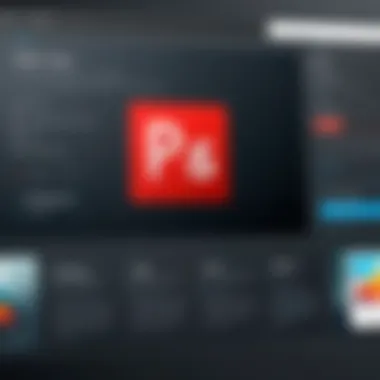A Comprehensive Guide to Installing Photoshop for Free


Intro
Installing Photoshop without paying for it raises various questions regarding legality and ethics. In this guide, we will discuss how users can utilize Adobe's offerings as well as secure and free alternatives, along with important considerations related to licensing. The intent is to provide clarity in choices, making it easier for those looking to access Photoshop's robust features without spending money.
Learning Photoshop can help immensely in various fields such as graphic design, photography, digital marketing, or web design. However, the financial burden can be a barrier for many aspiring users. This article will present ways to manage these challenges responsibly.
Understanding Adobe's Offerings
Adobe provides options for individuals unable to afford its software. These offerings make it possible for students and aspiring professionals to access the tools they need without hesitation.
One notable way is through Adobe's 7-day free trial, which allows new users to experience the full version of Photoshop. Sign up through Adobe's official website.
To ensure you get the most from your experience,
- Visit the official Adobe site, where the trial is prominently displayed.
- Create an Adobe ID, which is quick and free.
- Download the software once your account is set up.
While the free trial is limited in duration, it does grant full access to all features, enabling in-depth exploration of the software. It's a perfect opportunity for users to determine if Photoshop meets their needs before making a commitment.
Educational Discounts
For students and teachers, Adobe offers significant discounts on its Creative Cloud subscription. The eligibility typically includes:
- Current students or educators at accredited institutions.
- Proof of status may be required, often through an educational email address.
This contributes to a more affordable entry point for those pursuing studies in relevant fields. The reduced fee not only allows access to Photoshop but also to an entire suite of Adobe applications.
It's essential to abide by Adobe's licensing agreements. Violating these can lead to penalties, including fines.
Exploring Alternative Software
If Adobe's offerings do not suffice or fit particular needs, exploring alternative software is a viable option. Many programs offer similar functionalities to Photoshop without the associated costs. Some noteworthy options include:
- GIMP: An open-source image editor that provides powerful features typical of Photoshop. It has a steep learning curve but many tutorials available online can help.
- Krita: Primarily focused on digital painting, it's also useful for photo editing and manipulation. It is user-friendly and suited for artists.
- Paint.NET: While less complex, it provides a great balance of functionality and accessibility for simpler tasks.
Legal Implications of Unauthorized Downloads
Downloading Photoshop from unauthorized sources poses significant risks. Instances of unverified downloads may lead to malware or other security issues. Furthermore, using Photoshop without possessing a valid license constitutes as copyright infringement.
In addition to legal consequences, unauthorized software may lack the critical updates and support that Adobe regularly provides, which could hinder user experience and productivity.
A responsible approach involves leveraging the options outlined above, where users can engage with Photoshop’s capabilities legitimately and ethically. Understanding the implications can safeguard against potential pitfalls while enhancing the learning experience.
Understanding Photoshop and Its Importance
Adobe Photoshop stands as a cornerstone in the world of digital imaging. Its significance extends beyond mere photo editing; it serves as a powerful tool for creators across various disciplines. This section aims to elucidate why understanding Photoshop is essential, especially for those looking to harness its capabilities without incurring costs.
Overview of Photoshop
Photoshop is a raster graphics editor developed by Adobe Inc. Launched in 1988, it has evolved into an industry standard for image manipulation. The software allows users to modify and enhance photographs, create digital artwork, and design web graphics. Its extensive suite of features includes tools for painting, retouching, and compositing, making it indispensable for professionals in photography, design, and marketing.
Photoshop's intuitive interface, combined with its powerful functionality, enables users to achieve stunning results relatively quickly. The learning curve can be steep for beginners, but grasping its essential features provides a solid foundation for further exploration of digital creative processes.
Applications of Photoshop in Various Fields
Photoshop's versatility has made it a critical asset in numerous sectors. Below are some key applications:
- Photography: Professional photographers rely on Photoshop for retouching images, color correction, and creating photo composites. It enhances visual storytelling by allowing the manipulation of various elements within an image.
- Graphic Design: Designers use Photoshop to create layouts, logos, and marketing materials. The software supports various file types, making it easy to integrate into a larger design workflow.
- Web Design: Web designers utilize Photoshop for creating website mockups and optimizing images for the web. It allows precise control over aesthetics, contributing to better user experiences.
- Video Production: While primarily known for image editing, Photoshop can also be used to create graphics and titles for video content. Its integration with Adobe Premiere Pro enhances the workflow for video editors.
- Education: Many educational institutions incorporate Photoshop into their curricula. Students studying art, design, and digital media benefit from its comprehensive tools, preparing them for future careers.


Understanding Photoshop's role in these fields highlights its importance in both professional and creative environments. Mastery of the software not only enhances individual skill sets but also opens doors to valuable job opportunities.
Legitimate Ways to Install Photoshop for Free
Understanding legitimate ways to install Photoshop for free is crucial for users who want access to powerful features without crossing legal boundaries. This section will discuss the benefits of using authorized methods, which ensure both software integrity and compliance with licensing agreements. Installing Photoshop through legitimate channels not only supports the developers and maintains software quality but also reduces risks associated with unauthorized versions.
Trial Versions Provided by Adobe
Adobe offers a trial version of Photoshop that allows users to explore the software's capabilities without any financial commitment. The trial typically lasts for seven days, providing full access to all features. This period is an excellent opportunity for individuals, especially students and beginners, to assess whether the software meets their needs before making a purchase.
To download the trial version, you will need to visit Adobe's official website. You'll need to create an Adobe account if you do not already have one. This is a straightforward process that requires basic personal information. Once you have created an account, the download link for the trial version is readily available.
There are several advantages of using the trial version:
- Comprehensive Access: Users can experience all functionalities of Photoshop, including advanced tools and features.
- Learning Opportunity: It serves as a perfect platform for beginners to learn and familiarize themselves with the software.
- No Financial Risk: Users can try the software without any monetary obligation, giving them a way to decide if they want to invest in a full version later.
Educational Discounts and Free Versions for Students
For students and educators, Adobe provides significant discounts on its Creative Cloud subscription, which includes Photoshop. Many educational institutions also partner with Adobe to offer students and staff free or heavily discounted access to the software. This is a valuable resource for those studying graphic design, art, or any digital medium that utilizes Photoshop.
To access these discounts, students typically need to verify their status through their educational institution. This may involve using a school email address or providing identification. After verification, students can download and install Photoshop as part of the Creative Cloud package, often at a fraction of the cost or even for free.
Benefits of using educational discounts include:
- Affordable Access: Students can access professional tools at a price that fits a limited budget.
- Skill Development: With these tools readily available, students can hone their skills effectively, preparing them for future career opportunities.
- Software Updates: Subscribers benefit from regular updates and new features, keeping their tools relevant and up-to-date.
Using legitimate ways to install Photoshop ensures you maintain the integrity of your tools and support continued development. Whether you opt for trial versions or take advantage of educational discounts, these methods provide legal and reliable access to Photoshop.
Exploring Free Alternatives to Photoshop
In the realm of graphic design and photo editing, Adobe Photoshop remains a gold standard. However, not everyone can afford its subscription fees. This is where exploring free alternatives becomes vital for those eager to harness creative tools without financial burden. Understanding what alternatives exist and their capabilities allows users to make informed choices tailored to their needs. Free alternatives can provide sufficient functionality for different skill levels, making design accessible to students and budding creatives alike.
GIMP as a Viable Alternative
GIMP, or the GNU Image Manipulation Program, is a standout choice among the free alternatives. This open-source software offers a host of features similar to those found in Photoshop. Users can perform tasks like photo retouching, image composition, and even advanced image editing. The interface is customizable, allowing users to set up their workspace according to personal preference.
It also supports a wide range of file formats, making it versatile in handling various graphic needs. While the learning curve may not be as steep as Photoshop, users will still need to invest time in mastering its features. Tutorials are plentiful online, guiding beginners through the functionalities of GIMP, making it an excellent resource for individuals new to graphic design.
Krita for Digital Artists
Krita shines as an alternative for digital artists and illustrators specifically. With features designed around painting and drawing, it offers a tailored experience for artists working on concept art or comic creation. The interface is intuitive, emphasizing brush dynamics and layer management. It includes specialized tools such as vector art, text support, and a multitude of brushes designed for different techniques.
Another advantage is Krita’s support for animation, which is not commonly found in many free editing programs. This provides artists the ability to explore different mediums within a single application. Reviews highlight its robust community that continually contributes to its development. As a result, users can enjoy regular updates and new features.
Paint.NET: A Simplified Editing Tool
For those who seek simplicity, Paint.NET offers a less complex option without sacrificing quality. Initially developed as a more powerful version of Microsoft Paint, it has evolved into a popular tool for light editing tasks. Users will find it easier to navigate, making it suitable for those who are not yet comfortable with more complex software.
Paint.NET supports essential functions like layer editing, special effects, and a variety of plugins that expand its features. While it might not have all the advanced capabilities of Photoshop or GIMP, its fast performance and user-friendly interface make it an excellent starting point for individuals learning the basics of photo editing.
In summary, when considering free alternatives to Photoshop, GIMP, Krita, and Paint.NET present formidable options. Each software comes equipped with unique strengths that cater to various user preferences and skill sets, encouraging learning and creativity without the hurdle of cost.
Installing Photoshop through Official Channels
Installing Adobe Photoshop through official channels is a crucial aspect of acquiring the software. Using official methods not only ensures that you get the latest updates and features but it also safeguards against potential legal issues that arise from unauthorized downloads. Furthermore, by opting for official channels, users have access to customer support, which can be invaluable in troubleshooting problems during installation or while using the software.
Creating an Adobe Account


An Adobe account is a prerequisite for downloading and using Photoshop. Creating an account is straightforward and serves several purposes. First, it allows you to manage your software subscriptions, access tutorials, and back up projects stored in the Adobe cloud.
To create an account, visit the Adobe website and click on the "Sign Up" button. You will be prompted to provide essential details such as your name, email address, and a password. Once your account is verified through your email, you can start exploring Adobe's offerings, including the free trial of Photoshop. An Adobe account may seem like a minor step, but it is a gateway to a wealth of resources and functionalities.
Downloading and Installing the Software
Once you have set up your Adobe account, downloading and installing Photoshop is the next logical step. This part of the process involves a few important considerations to ensure a smooth installation.
System Requirements
Before downloading Photoshop, it's essential to check the system requirements. These specifications dictate whether your computer can run Photoshop effectively. Key characteristics include:
- Operating System: Windows 10 or later, or macOS versions specified by Adobe.
- Processor: A multi-core Intel processor or AMD with 64-bit support.
- RAM: At least 8 GB, though 16 GB is recommended for optimal performance.
- Hard Disk Space: A minimum of 4 GB of available space for installation, with additional space required for working files.
Meeting these requirements is beneficial as it prevents potential performance issues. Software running on incompatible systems can lead to crashes and an overall poor user experience. It is advisable to use a device that meets or exceeds these specifications for the best results.
Installation Steps
The installation process of Photoshop can be broken down into manageable steps. The key characteristic of these steps is their simplicity, making it easy even for those with limited technical expertise. Here’s a brief guide:
- Sign in to your Adobe Account: Navigate to the Creative Cloud section of the Adobe website and log into your account.
- Locate Photoshop: Find the Photoshop application and select the option to download it.
- Follow Installation Prompts: Download the installer and run it. Follow the on-screen instructions.
- Complete Setup: Once installation is complete, launch Photoshop and log in using your Adobe account.
These steps make it straightforward to get Photoshop up and running on your device. They also ensure that you install the software correctly, which is essential for avoiding common pitfalls. The process is designed to minimize complexity, making it accessible for users at various skill levels.
Ethical Considerations in Software Use
Ethical considerations play a central role in how individuals and organizations utilize software like Adobe Photoshop. In this digital age, where access to technology significantly shapes the creative landscape, understanding these considerations is essential for anyone looking to engage with software responsibly.
First, adhering to software licensing agreements protects the rights of creators and developers. Software companies invest substantial resources into developing their products. These licenses outline how the software can be used and the restrictions placed upon users. A clear understanding of these agreements is not just a legal requirement; it fosters respect for intellectual property and innovation within the tech and creative communities.
Moreover, ethical software use promotes fair competition. When individuals resort to unauthorized downloads and use of software, they undermine the market. This behavior can lead to higher prices for legitimate users and stifle innovation. Encouraging proper channels fosters an environment where developers are rewarded for their work, leading to better products in the long run.
Another critical aspect is the potential harm unauthorized software use can cause. Not only does it expose users to malware and security risks, but it can also lead to software instability. These issues can detract from the user experience and impact productivity negatively. Thus, considering the ethical stance of using legitimate software options is vital for maintaining personal and professional integrity.
In summary, recognizing and implementing ethical considerations in software use is paramount. It benefits not only the user but also the broader community and the economy as a whole.
Understanding Software Licensing Agreements
Software licensing agreements are legally binding contracts between the software provider and the end user. Understanding these agreements is vital for anyone wishing to use applications like Photoshop. They delineate the rights and responsibilities of the user, making it clear what is permissible and what is not.
- Types of Licenses: Common licenses include single-user, multi-user, and educational licenses. Each type caters to different user needs. For example, academic licenses often come at a reduced cost, targeting students and educators.
- Terms and Conditions: These agreements outline how the software can be used. They often specify installation limits, usage restrictions, and the conditions under which the software may be installed on multiple devices.
- Consequences of Violation: Breaching these agreements can result in penalties, including fines. It can also lead to revoked access to software and cloud services.
Understanding software licensing agreements helps users make informed decisions regarding their software usage, ensuring compliance and fostering a respect for intellectual property.
Legal Implications of Piracy
Piracy refers to the unauthorized use, reproduction, or distribution of software. Engaging in software piracy has serious legal implications. Users must recognize the potential consequences of such actions.
First, individuals caught using pirated software can face substantial fines or even criminal charges. Laws vary by jurisdiction, but many countries have strict regulations against piracy. In some cases, repercussions can extend to both individuals and businesses, impacting their reputation and financial standing.
Furthermore, software piracy damages the entire software ecosystem. When developers cannot recover their investment due to widespread unauthorized use, it can lead to a decline in innovation and quality of software products. This reflects negatively on the available options for all users.
It is important to note that engaging in piracy also poses risks to the user’s security and privacy. Pirated versions of software often come bundled with malware or other malicious components, which can compromise personal and organizational data.
Recognizing Risks Associated with Unauthorized Downloads
Unauthorized downloads of software like Adobe Photoshop raise several significant concerns. As tempting as it may be to access the software without any cost, understanding the risks is crucial. The implications can affect not only the integrity of your computer system but also your personal information and overall experience with the software itself. Knowing these risks can help users make informed decisions and prioritize safe practices.


Malware and Security Risks
One of the most severe dangers of downloading Photoshop from unauthorized sources is the risk of malware. Cybercriminals often embed malicious software into unauthorized copies of popular programs. When a user unknowingly downloads these files, they may inadvertently install harmful malware that infects their computer.
Here are some common types of malware associated with unauthorized downloads:
- Viruses: These can corrupt files and damage the operating system.
- Spyware: This type secretly collects user data, which can result in loss of privacy.
- Ransomware: This malicious software locks your files and demands payment for access.
Additionally, downloading software from unverified sites opens the door for potential phishing attacks. Users may find themselves compromising their personal or financial information without knowing it.
Potential Software Instability
Software instability is another reliable outcome from unauthorized downloads. Programs that are not properly installed can be prone to frequent crashes or errors. These issues arise for several reasons, including missing files or incorrect configurations that often accompany pirated versions.
Consequently, users may experience:
- Frequent crashes: This disrupts workflow and can lead to data loss.
- Incompatibility issues: Many features may not work as intended, particularly if updates are unsupported.
- Limited functionality: Some unauthorized versions may lack essential features leading to a frustrating user experience.
In summary, while free downloads can seem appealing, the potential risks outweigh any initial cost savings. From harmful malware to software instability, users should consider the long-term implications of their choices regarding unauthorized downloads. Prioritizing ethical and secure practices ensures a better experience with significant software like Adobe Photoshop.
Frequently Asked Questions
The section on Frequently Asked Questions serves a vital purpose in this article. It acts as a resource to clarify doubts that potential users may have regarding the installation and use of Adobe Photoshop. By addressing common uncertainties, we empower users with knowledge to make informed decisions. This reduces the chance of confusion and enhances the overall user experience, particularly for those who may be less familiar with software installation processes.
Is it possible to get Photoshop for free legally?
Yes, it is possible to get Photoshop at no cost through legitimate means. The most direct way is to utilize the trial version provided by Adobe. Adobe offers a free trial of Photoshop that usually lasts for seven days. This trial grants access to the full arsenal of features available in the latest version. Potential users can download it directly from Adobe’s official website. However, at the end of the trial period, a subscription is required to continue using the software.
Another option comes for students and teachers. They can take advantage of educational discounts or even free offers that some educational institutions may present. If you are a student or know someone in academia, it's worth checking whether your school has a partnership with Adobe. This often leads to free or heavily discounted software.
What are the best free alternatives to Photoshop?
There are several noteworthy alternatives to Photoshop, which can serve specific needs without the financial burden. Here are a few:
- GIMP: GIMP is an open-source image editor known for its extensive features, making it a versatile Photoshop alternative. It is suitable for tasks ranging from simple image editing to complex graphic design work.
- Krita: This software is particularly favored by digital painters and illustrators. It's free and offers tools tailored for digital artistry.
- Paint.NET: A simpler tool, Paint.NET is user-friendly and offers essential editing features without overwhelming interfaces.
These alternatives can cater to a variety of user requirements based on different skill levels and editing needs.
What should do if encounter issues during installation?
Issues during installation can arise for several reasons. If you encounter problems, consider the following steps:
- Check System Requirements: Make sure your system meets all required specifications for Photoshop.
- Internet Connection: A stable internet connection is essential during the download and installation process.
- Anti-Virus Settings: Sometimes, antivirus programs can interfere with installation. Temporarily disabling them might help.
- Update Operating System: Ensure your operating system is up-to-date because old systems might encounter compatibility issues.
- Contact Support: If problems persist, reach out to Adobe’s customer service for assistance. They can provide guidance tailored to your specific situation.
Addressing these common issues can lead to a smoother installation process, ensuring that users can start utilizing Photoshop's capabilities without frustration.
The End
In this article, we explored various routes to install Adobe Photoshop without incurring costs. Understanding the options available is essential for users who wish to leverage the full potential of Photoshop's features in a budget-friendly manner. The insights presented emphasize the importance of utilizing legitimate resources to obtain software. This not only respects the hard work of the developers but also ensures that users avoid potential legal quandaries associated with software piracy.
Summary of Installation Options
Many pathways exist for obtaining Photoshop at no charge. The most reliable avenue includes taking advantage of Adobe’s trial versions, which allow users to explore the software fully for a limited time. Additionally, students can benefit from educational discounts, making the software far more accessible while retaining compliance with licensing agreements.
- Trial versions: A great way to experiment before commitment.
- Educational discounts: Special pricing for students and educators.
Alternatives such as GIMP, Krita, and Paint.NET provide robust functionalities similar to Photoshop. Recognizing and evaluating these options allow users to select the right tool for their unique needs while ensuring compliance with software ethics.
Final Thoughts on Using Photoshop Responsibly
Using Photoshop responsibly transcends merely installing the software without payment. Users must consider ethical dimensions and potential repercussions of unauthorized downloads. It is crucial to understand licensing terms and the broader implications of software piracy. Engaging in responsible software use fosters a culture of respect for intellectual property and supports continuous innovation in the tech field.
Ultimately, embracing legitimate resources and seeking educational opportunities to access tools like Photoshop fosters a positive ecosystem for both users and developers alike. Encourage others to follow similar paths; together, we can ensure that creativity and legal responsibility coexist.







